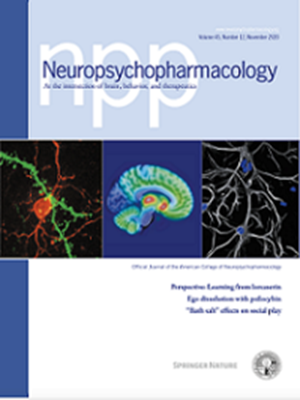青少年四氢大麻酚诱导阿片反应增强的神经基础。
IF 6.6
1区 医学
Q1 NEUROSCIENCES
引用次数: 0
摘要
使用一种成瘾性药物通常会影响对其他药物的行为反应,要么在同一时间施用,要么在随后的时间点施用。所使用药物的性质,以及时间和剂量,也影响这些药物如何相互作用。在这里,我们测试了青少年四氢大麻酚暴露对吗啡诱导的行为适应在成年期反复暴露后的发展的影响。我们发现,青少年服用四氢大麻酚可以防止在吗啡服用后强制戒断期间出现的焦虑相关行为的发展,但却促进了吗啡CPP的恢复。在强制戒断后,我们绘制了全脑对中等剂量吗啡的反应图,发现青少年服用四氢大麻酚导致全脑神经元活动的总体增加,并增加了额叶皮质区和腹侧被盖区之间的功能连通性。最后,我们使用狂犬病毒为基础的电路映射显示,青少年接触四氢大麻酚会触发额叶皮质区域与腹侧被盖多巴胺细胞之间的连接长期升高。我们的研究增加了关于药物之间相互作用的丰富文献,包括四氢大麻酚和阿片类药物,并提供了青少年四氢大麻酚暴露影响以后生活中对吗啡反应的潜在神经底态。本文章由计算机程序翻译,如有差异,请以英文原文为准。

Neural basis of adolescent THC-induced potentiation of opioid responses later in life
Use of one addictive drug typically influences the behavioral response to other drugs, either administered at the same time or a subsequent time point. The nature of the drugs being used, as well as the timing and dosing, also influence how these drugs interact. Here, we tested the effects of adolescent THC exposure on the development of morphine-induced behavioral adaptations following repeated morphine exposure during adulthood. We found that adolescent THC administration paradoxically prevented the development of anxiety-related behaviors that emerge during a forced abstinence period following morphine administration but facilitated reinstatement of morphine CPP. Following forced abstinence, we then mapped the whole-brain response to a moderate dose of morphine and found that adolescent THC administration led to an overall increase in brain-wide neuronal activity and increased the functional connectivity between frontal cortical regions and the ventral tegmental area. Last, we show using rabies virus-based circuit mapping that adolescent THC exposure triggers a long-lasting elevation in connectivity from the frontal cortex regions onto ventral tegmental dopamine cells. Our study adds to the rich literature on the interaction between drugs, including THC and opioids, and provides potential neural substates by which adolescent THC exposure influences responses to morphine later in life.
求助全文
通过发布文献求助,成功后即可免费获取论文全文。
去求助
来源期刊

Neuropsychopharmacology
医学-精神病学
CiteScore
15.00
自引率
2.60%
发文量
240
审稿时长
2 months
期刊介绍:
Neuropsychopharmacology is a reputable international scientific journal that serves as the official publication of the American College of Neuropsychopharmacology (ACNP). The journal's primary focus is on research that enhances our knowledge of the brain and behavior, with a particular emphasis on the molecular, cellular, physiological, and psychological aspects of substances that affect the central nervous system (CNS). It also aims to identify new molecular targets for the development of future drugs.
The journal prioritizes original research reports, but it also welcomes mini-reviews and perspectives, which are often solicited by the editorial office. These types of articles provide valuable insights and syntheses of current research trends and future directions in the field of neuroscience and pharmacology.
 求助内容:
求助内容: 应助结果提醒方式:
应助结果提醒方式:


